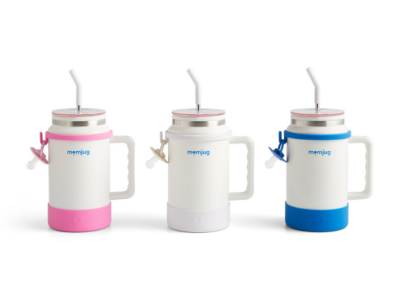You know how they say a person’s eyes are the windows into their soul? Well, at Little Spoon, we like to say a baby’s poop is the window into their health. It may sound silly, but it’s 100% true.
Closely monitoring your little one’s bowel movements—and any changes in frequency, color, and consistency—can give you important insights into your baby’s health, and can alert you to any potential issues right away.
But babies’ poops come in all different shapes, sizes, textures, and yes, smells—so we’re here to demystify what normal baby poop looks like, how new foods can affect your baby’s digestion, and when it might be time to contact your doctor.
While this guide can help you decide what’s within the realm of normality—across frequency, color, and consistency—and what could be a cause for concern, you should never hesitate to reach out to your pediatrician with any concerns around your baby’s bowel movements—or anything else. Your doctors are there to support you and your little one in this exciting, transitional period for the whole family!
The first few days
We’re going to be real with you—a baby’s first poop can be a bit shocking if you don’t know what to look for! A newborn’s first poop is typically black, tarry, sticky, and shiny—and that’s totally normal.
This first poop—which should pass within the first 24 hours after birth—is called the “meconium” and is made up of everything the baby ingested while in utero: amniotic fluid, skin cells, mucus, and more. A baby’s first bowel movement should get all of this out, so expect that your baby’s poop will change in color, consistency, and smell (the meconium blissfully smells like nothing—enjoy it while it lasts!) over the next couple days.
Color
Often, the first thing parents worry about is the color of their baby’s poop—for good reason! Baby poop colors come in all shades of the rainbow, and it can be alarming, but changes in color can be totally normal—it’s typical for a baby’s poop to be a range of different colors depending on how old they are and what they’re eating.
Overall, a good rule of thumb is for parents to keep tabs on color, but not to get alarmed if colors change—especially as the baby starts eating solid foods. Once you start transitioning your baby to solid foods, their poop will start to change—mostly in terms of consistency, and smell.
Below, we’ve outlined the most common baby poop colors, what they indicate, and when it’s time to call the doctor.
Mustard yellow
This is the typical poop color for breastfed babies, whose poops will often be runnier in consistency. Don’t be alarmed if you see small seed-like flecks in the stool—these are small curds of breast milk, and it’s totally normal!
Tannish brown
This is the normal poop color for formula-fed babies, whose poops will often be thicker and more paste-like—similar to the consistency of peanut butter.
Dark brown
You likely won’t see a truly brown poop until your baby begins eating solid foods—this is when their poop will become more consistently brown—and smelly—as a range of good bacteria is introduced to their gut through the new foods they’re eating.
Green
Seeing that your baby’s poop is green can be alarming to a new parent—but for the most part, it’s totally normal. Green poop can be different things, depending on whether you’re feeding your baby breastmilk, formula, or solid foods.
For babies that are on formula or a solid food diet, dark green poop stems from increased iron in a baby’s formula or solid foods. Little Spoon’s Stage 2 and 3 baby blends are packed with iron-rich green foods like spirulina, broccoli, and spinach, which can definitely lead to green-hued stools.
For breastfed babies, however, bright green poop with a frothy texture can be a sign that the baby is consuming too much foremilk (the milk that comes first in a feeding) and not enough of the higher fat, nutrient-dense hindmilk. To remedy this, try breastfeeding on a single breast for each feeding, and feeding for longer periods of time.
Poop with a yellowish-green hue is also largely normal—if your baby seems comfortable and happy, it’s likely that all is well. If your baby seems uncomfortable—bloated, gassy, or generally fussy—paired with green poop, this could be an indication that the baby is fighting a stomach bug, or is reacting negatively to the formula (potentially due to a cow’s milk allergy).
Bright yellow or orange
For breastfed babies, seeing orange or yellow in your baby’s diaper is likely a reaction to a change in mom’s diet or medications —any artificial dyes that a mom consumes through food or drinks can make its way into her breastmilk, and change the color of baby’s stools. This is normal and shouldn’t be a cause for concern, but always make sure to run any significant dietary or medication changes by your doctor or pediatrician, to make sure it’s safe for your breastfed little one.
Red
If your little one’s stool is entirely red or visibly bloody, contact your pediatrician immediately—this could be the sign of an allergy or damage to the GI tract.
If there’s just a few flecks of red in an otherwise yellow or brown stool every now and then, don’t worry—this could be a result of mild constipation, or even from swallowing small flecks of blood from nipple chafing during breastfeeding! However, it’s always a good idea to run any new changes to your baby’s stool color by your pediatrician, just to be safe.
Black
As we mentioned, a newborns’ first poop will often be a dark, sticky, tarry black. After that first poop, however, their bowel movements should become thinner and more watery, regardless of whether they’re being fed breastmilk or formula.
If your baby’s poop remains sticky and black after the first few days, consult your pediatrician immediately—your little one might not be absorbing enough nutrients from feedings.
Gray or white
For babies who have not yet started eating solids, gray or white chalky poop could be an indication of a liver or gallbladder issue—consult your pediatrician immediately.
Frequency
While many new parents expect to pay close attention to the color of their new little one’s stools, frequency is also an important thing to consider, especially in the first few weeks.
Pooping frequency evolves with a baby’s age and diet. Initially, newborn babies will poop after every feeding, up to 5-10 times per day. It’s important to know that what you feed your baby will affect how often they poop. Typically, formula-fed babies will likely poop less often than breastfed babies, but will have more substantial, thicker, and darker stools.
Meanwhile, breastfed babies tend to have more frequent, runnier stools, often flecked with what looks like small seeds (these are curds of breast milk). You might be worried this is diarrhea, but runny stool is completely normal for breastfed babies—just make sure to monitor for any notable changes in the consistency or color.
After 6 weeks, the baby’s digestive tract develops, and the poop habits can change, so don’t be alarmed if your baby begins pooping only once per day, or even every other day, at this stage.
Constipation
There are many reasons why a baby might not be pooping as frequently—whether it’s a result of dehydration, an allergy, or changes to routine or habits (the same way you might get a little backed up while traveling—your baby can, too!) If you’re regularly noticing your baby is not pooping for any of these reasons, contact your pediatrician—anything that becomes a pattern should be flagged.
For babies of all ages and baby food stages: a warm bath, increased water intake, and gently bicylign a baby’s legs can be great ways to manually stimulate your baby’s tummy.
For babies who have started eating solids, there are a range of Stage 1 foods that help safely encourage bowel movements, like Prunes, peaches, and pears. For babies that are further along in the baby food stages, and are beginning to transition into baby-led weaning (at around 10-12 months old), Stage 5 blends with veggies and whole grains are also great stimulants to get the bowels moving.
For some babies, frequent gas and colic can be a sign that they’re not yet ready for solid foods, and should stick to their previous breastmilk or formula diet for a little bit longer.
Consistency
Consistency often goes hand in hand with color and frequency, but it’s worth noting on its own. The same factors that affect your little one’s stool frequency and color can also affect consistency—especially if your baby’s routine is changed for travel or other reasons.
The important thing to look out for is that the baby’s stools return to normal in a couple bowel movements. If the new consistency persists, it’s time to consult your pediatrician.
Below are a few of the common consistency changes, and what they can mean for your little one’s health:
Diarrhea
Frequent loose stools can be a sign of an allergy or infection. As soon as you see diarrhea in your baby’s diaper for more than one bowel movement, contact your pediatrician—it’s very easy for babies to become dehydrated from prolonged diarrhea.
Mucousy
The occasional appearance of mucus in a baby’s stool can be normal—babies swallow a lot of saliva and drool after all! But consistently mucousy stool could indicate an infection or allergy, so it’s best to consult your pediatrician if you notice it becoming a pattern.
Bloody
Seeing red in your babys’ poop isn’t always cause for alarm: a few flecks means something different than an entirely red stool. As we mentioned in the section on color—if your little one’s stool is entirely red or visibly bloody, contact your pediatrician immediately—this could be the sign of an allergy or damage to the GI tract.
Pebbly
Firm, small, pebble-like poops are typically a sign of constipation, especially when you’re starting to transition your baby to solid foods. This will usually resolve itself as a baby’s digestive system gets used to a new ingredient, but you should consult your pediatrician after more than two pebbly poops in a row. It could be a sign of a food sensitivity or allergy.
Undigested food
Seeing whole pieces of food in your baby’s poop can be alarming, but it can be totally normal, especially as a baby begins transitioning to solid foods. Some more fibrous foods—like veggies and whole grains—travel more quickly through a baby’s digestive tract without fully breaking down, which means you might see chunks of carrots in your baby’s poop. Don’t sweat it!
When to call your doctor
As a rule of thumb, don’t hesitate to contact your pediatrician if you’re concerned about any new developments with your little one’s poops. A few times when you should definitely contact your pediatrician include:
- When your baby is constipated—when a breastmilk-fed baby hasn’t pooped in over three days, or when a formula-fed baby hasn’t pooped in over five days
- When a baby on any diet has poop that is:
- Thick, hard, or pebbly for more than two stools
- Red or black with any stool
- White or gray, and chalky in texture with any stool
- Much more frequent than usual.
Whenever consulting your pediatrician, it’s always helpful to bag up the diaper with the poop in question and bring it along with you for your visit, so they can evaluate the sample firsthand. Stinky, we know, but a sealed plastic bag should keep the smells contained, and could make the world of difference over just pictures for getting your little one some immediate help!
Getting to know your baby is an exciting, life-changing process, and getting to know the ins and outs of your little one’s personality is just as important as getting to know the evolving ins and stinky outs of their changing little bodies. So keep a close eye on those diapers, and don’t worry—in no time, you will become a baby poop expert!



